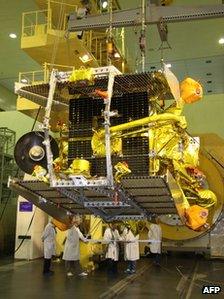Stranded Mars probe sends further signals
- Published

Phobos-Grunt is Russia's most ambitious space venture in years
More attempts have been made by the European Space Agency (Esa) to contact the stricken Russian probe Phobos-Grunt - with partial success.
Communication with the craft as it passed over Australia was achieved again on Thursday, but not all of the commands prompted a response.
Phobos-Grunt was launched two weeks ago on a mission to visit one of Mars' moons, but became stuck in Earth orbit.
Engineers still hope to fix the probe and get the mission under way.
But first they need to be able to talk with it. Europe's 15m dish in Perth, external was the first to successfully make contact with the spacecraft in a fortnight of trying by tracking stations around the globe.
Esa modified the big antenna to widen its beam, and also reduced the power of the transmission to match the type of X-band signal Phobos-Grunt would have expected to receive nearer the Red Planet.
On Wednesday (Western Australia), those modifications prompted the probe to switch on its transmitter and send down some basic telemetry. On Thursday, a further five efforts were made to contact the spacecraft, with the first at 0420 local time (2020 GMT, Wednesday) also initiating a stream of data from Phobos-Grunt.
But the next four passes saw nothing come back down.
"The first Perth pass worked in both directions and even this time the signal strength was better than on the previous night, most likely because we had better pointing data," explained Dr Manfred Warhaut from Esa's European Space Operations Centre in Darmstadt, Germany.
"We've had some [information] we've now passed to the Russians. So, a glimpse of hope, but all this is a very, very challenging task," he told BBC News.
Phobos-Grunt moves very fast across the sky, giving an opportunity for communication that lasts little more than five minutes to upload commands and receive telemetry.
The situation is now being assessed by engineers at the probe's Russian manufacturer, NPO Lavochkin. Esa says it stands ready to help in any way, and will continue to work with Russian engineers and the Russian space agency (Roscosmos) as they try to diagnose the mission's problems and find a solution.
Phobos-Grunt may still have a short window in which to start its journey across space before a change in the alignment of the planets makes the distance to Mars too big to cross.
The probe was built to land on the larger of Mars' two moons, Phobos, and scoop up rock to bring back to Earth.
Such a venture should yield fascinating new insights into the origin of the 27km-wide object and the planet it circles.
The mission is also notable because China's first Mars satellite, Yinghuo-1, has been launched piggy-back on the main Russian spacecraft.
Even if the Mars opportunity is lost, if engineers can get the probe working properly it might still be possible to re-task it to visit a new target, such as an asteroid.
"Whatever happens, it's important that we at least try to understand what happened in order to avoid such a mishap occuring again in the future," commented Dr Warhaut. "This is why we do all this work."
- Published22 November 2011
- Published21 November 2011
- Published10 November 2011